16 Beautiful Plants that Thrive Under Maple Trees
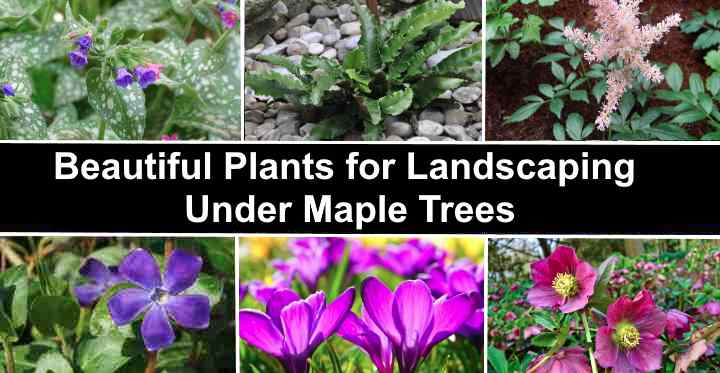
Finding plants for landscaping under maple trees can be challenging. Most maples have shallow, aggressive roots, and the tree’s canopy creates dense shade. This means many plants struggle in dry, shady conditions with low soil nutrient levels. However, choosing the right plants can turn a barren maple tree understory into a beautiful and thriving landscape.
The best shade-loving plants that thrive under maples in dry soil conditions are periwinkle, astilbe, lungwort, lily of the valley, creeping phlox, and crocuses. These attractive plants add color and texture to the area under maple trees. They also help to suppress weeds and prevent soil erosion where maple trees are growing.
This article provides a selection of beautiful plants suitable for landscaping under maple trees. Descriptions and pictures of these plants will help you create a stunning garden bed beneath your maple tree.
What to Plant Under Maple Trees
The best plants for growing under maple trees tolerate shade and drought and have shallow roots. Maple tree companion plants include ferns, crocuses, periwinkles, and flowering ground covers for shade. These shady garden plants don’t require much moisture or nutrients to thrive on the ground around maple trees.
Why Most Plants Fail Under Maple Trees
Planting under maple trees poses challenges due to the dense shade they create, limiting the amount of sunlight that reaches the ground. As a result, sun-loving plants will struggle to thrive in such conditions.
Additionally, the competitive and extensive root systems of maple trees absorb much of the water and nutrients in the soil, leaving little for neighboring plants, which can result in stunted growth and difficulty establishing strong root systems.
Beautiful Plants For Landscaping Under Maple Trees
The good news is that several exquisite plants are perfect for landscaping under maple trees. They can transform shade into vibrant beauty with lush green foliage and colorful flowers that create a captivating and lush space beneath maples.
Plants for Growing Under Maple Tree Dense Canopy
The most challenging part of landscaping under maple trees is the area directly under the canopy. The ground around the maple trunk is nutrient-deficient and shrouded in shade for most of the day. Here are some excellent solutions for underplanting maple trees.
Periwinkle (Vinca minor)

Periwinkle is a hardy ground cover plant that thrives in the dry shade of maple trees. It has small, shallow roots but it can withstand the aggressive maple roots. This attractive mat-forming perennial has five-petaled purple flowers contrasting with glossy dark green lanceolate leaves. The maple companion plant blooms from mid-spring and then intermittently until fall. It’s one of the best ground cover plants for growing under maple trees.
Periwinkle has several features, making it ideal as a maple understory plant. Besides its drought tolerance, the shade-tolerant plant is resistant to deer, pests, and diseases.
- USDA Planting Zone: 4 to 9
- Sun Exposure: Full sun, partial shade, deep shade
- Blooming Season: Spring through fall
- Mature Size: 4” to 6” (10 – 15 cm) tall and spreads indefinitely
- Growth Rate: Fast-spreading ground cover
Lungwort (Pulmonaria)
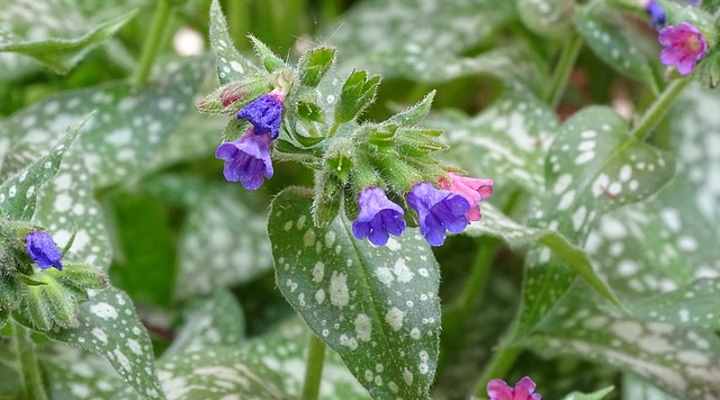
Lungwort is a spectacular shade-friendly companion plant for growing under maple trees. The low-growing, clump-forming plant has attractive bell-shaped flowers blooming throughout spring. These colorful blossoms turn woodland floors into shades of pink, violet, and deep purple. Lungwort also has large lance-shaped spotted leaves contrasting nicely with the clusters of funnel-shaped flowers.
Lungwort is an easy-to-grow plant that thrives in shaded, well-drained garden areas. Its early-season blooms add color and texture around maple trees when little else grows. Additionally, lungwort is deer-resistant and attracts pollinators like bees and butterflies.
- USDA Planting Zone: 3 to 9
- Sun Exposure: Partial shade to full shade
- Blooming Season: Spring
- Mature Size: 8” to 12” (20 – 30 cm) tall and up to 24” (60 cm) wide
- Growth Rate: Moderate growth rate, forming clumps over time
Pennsylvania sedge (Carex pensylvanica)

Pennsylvania sedge is a great landscaping solution for growing grass in the shade of maple trees. This clumping decorative grass has finely textured arching leaves that form dense clumps. It also blooms with small clusters of whitish, inconspicuous flowers. This sedge plant is an excellent lawn substitute for dry shade underplanting maple trees.
Pennsylvania sedge grows up to 2 ft. (0.6 m) tall, and it’s easy to grow without much care. You can plant it to create a lawn-like effect in woodlands where traditional grass cannot grow. It attracts beneficial insects like bees and butterflies but not deer.
- USDA Planting Zone: 3 to 8
- Sun Exposure: Partial shade to full shade
- Blooming Season: Insignificant blooms in spring
- Mature Size: 1 to 2 ft. (0.3 – 0.6 m) tall and 1 ft. (0.3 m) wide
- Growth Rate: Slowly spreads to form a dense ground cover over time
Astilbe
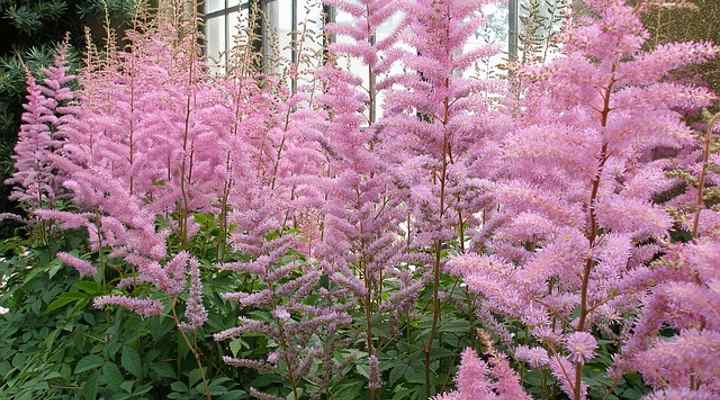
Chinese astilbe (Astilbe chinensis)
Astilbe is one of the best flowering plants for landscaping under a maple tree. Blooming in late spring and summer, the shade-tolerant plant blooms with feathery plumes of white, red, or pink flowers. Additionally, attractive fern-like foliage covers bare ground in shady woodland areas. Astilbe grows up to 5 ft. (1.5 m) tall.
Astilbe prefers well-drained soils in fully shaded locations. However, some moisture during warmer weather may be required for optimal growth. The versatile maple companion plant is deer-resistant but attracts pollinators like bees and butterflies. Its feathery foliage and showy flowers add color and texture to the ground under maple trees.
- USDA Planting Zone: 3 to 9
- Sun Exposure: Full sun, partial shade, heavy shade
- Blooming Season: Late spring to until the end of summer
- Mature Size: 1 to 5 ft. (1 – 1.5 m) tall and up to 2 ft. (0.6 m) wide
- Growth Rate: Moderate growth rate with upright, leafy, flowering stems
Hakone Grass (Hakonechloa macra)

Hakonechloa macra ‘All Gold’
Hakone grass is a beautiful ornamental grass ideal for growing in the shade of large maple trees. The decorative features of the rich-green grass are its arching leaves, excellent fall color of coppery-orange, and airy sprays of green flowers. It’s tolerant of cold, sun, drought, and full shade.
Hakone grass is one of the best plants to grow under trees because it adds lush texture and movement to woodland gardens. It’s an ideal landscaping solution as a turfgrass alternative because grass struggles to grow under Japanese maples and tall maple trees. The grass is also resistant to deer and serves as a beautiful backdrop that accentuates the charm of your maple tree.
- USDA Planting Zone: 5 to 9
- Sun Exposure: Full sunlight, partial shade, deep shade
- Blooming Season: Insignificant flowers in mid to late summer
- Mature Size: 1 to 3 ft. (0.3 – 0.9 m) tall and wide
- Growth Rate: Slow growth rate
Ferns For Landscaping Under Dense Maple Tree Canopy
Planting ferns under maple trees adds elegance to the shade garden. Their lush, feathery fronds thrive in low light and moist soil, creating a cool and tranquil under-canopy oasis.
Here are descriptions of two ferns that thrive in the growth conditions maple trees create:
Painted Lady Fern (Athyrium niponicum var. pictum ‘Burgundy Lace’)
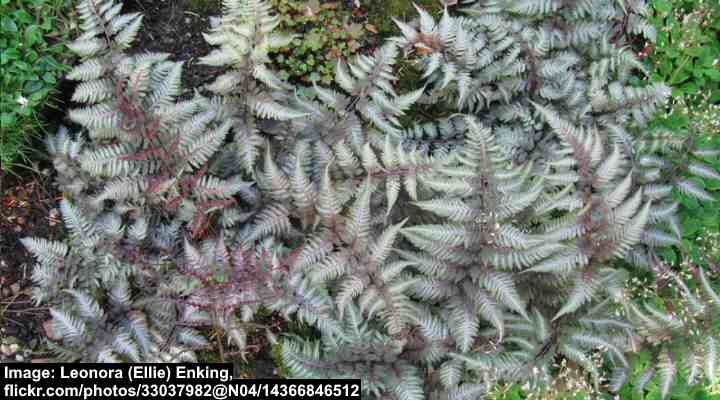
The painted lady fern is a deciduous plant that tolerates dry shade better than other ferns. Ideal for growing around maple trees, the ‘Burgundy Lace’ fern has stunning lacy fronds in eye-catching burgundy. The fronds mature to silvery-green colors but retain their reddish-burgundy midribs.
- USDA Planting Zone: 5 to 8
- Sun Exposure: Partial shade to full shade
- Mature Size: 1 to 2 ft. (0.3 – 0.6 m) tall and wide
- Growth Rate: Slowly spreads over time
Hart’s Tongue Fern (Asplenium scolopendrium)

Hart’s tongue fern is a striking evergreen plant, ideal for growing in shaded areas at the base of maple trees. This evergreen fern has long, glossy, strap-like fronds in the shape of a tongue growing in a rosette pattern. The fern tolerates shade and well-drained soils but may struggle in acidic soils.
- USDA Planting Zone: 5 to 9
- Sun Exposure: Partial shade to full shade
- Mature Size: 1 to 2 ft. (0.3 – 0.6 m) tall and wide
- Growth Rate: Slowly spreads over time
Plants for Growing Under Maple Tree Canopy Edge
Many varieties of flowering plants are tolerant of partial shade and perform better at the edge of maple tree canopies.
Canada Violet (Viola canadensis)

Canada violet is a white-flowering perennial plant that looks stunning in partially shaded landscapes. Thriving near maple trees, the clump-forming plant has five-petalled white flowers with yellow markings and purple veins. The brilliant flowers contrast nicely with heart-shaped leaves growing up to 4” (10 cm) long.
Canada violet flowers add a splash of color to the shaded areas around maple trees. The low-growing plant thrives in dappled sunlight and well-drained soils. It performs best at the edge of the maple canopy because it benefits from moist soil. The white flowers bloom from summer to fall.
- USDA Planting Zone: 3 to 8
- Sun Exposure: Partial shade
- Blooming Season: Summer through fall
- Mature Size: 1 to 2 ft. (0.3 – 0.6 cm) tall and wide
- Growth Rate: Slow growth rate, forming dense clumps over time
Roundleaf Liverleaf (Hepatica americana)

Roundleaf liverleaf is a beautiful purple, white or pink-flowering understory plant for growing around maple trees. The eye-catching features of this plant are its cup-shaped flowers and round, three-lobed leaves on fuzzy stems. Blooming in early spring, roundleaf liverleaf anemone-like flowers add a touch of color to maple environments.
Growing less than a foot (0.3 m) tall, this liverleaf variety blooms before the tree canopy fully leaves out. Therefore, it gets enough sunlight to produce an attractive floral display. The hardy perennial comes back year after year, making it a great addition to woodland gardens, providing a burst of color in the early spring.
- USDA Planting Zone: 3 to 8
- Sun Exposure: Partial shade
- Blooming Season: Early spring
- Mature Size: 6” to 9” (15 – 23 cm) tall and wide
- Growth Rate: Slow growth rate, forming dense clumps over time
Golden Columbine (Aquilegia chrysantha)

Golden columbine is a beautiful yellow-flowering perennial plant that thrives in dappled sunlight around maple trees. This native wildflower is characterized by its bright yellow, bell-shaped flowers nodding on slender stems. The eye-catching yellow flowers contrast with the plant’s delicate, fern-like foliage. It blooms for several weeks from mid-spring.
Golden columbine is an ideal landscaping option for planting at the edge of maple tree canopies. Its brightly colored, golden yellow flowers attract bumble bees, butterflies, and hummingbirds. Ideal for full sun or moderate shade, it brightens the understory of maple woodlands.
- USDA Planting Zone: 3 to 8
- Sun Exposure: Full sun, dappled sunlight, or moderate shade
- Blooming Season: For several weeks from late spring to late summer
- Mature Size: 3 to 4 ft. (1 – 1.2 m) tall and 2 ft. (0.6 m) wide
- Growth Rate: Vigorous growth habit
Lenten Roses – Hellebore (Helleborus)
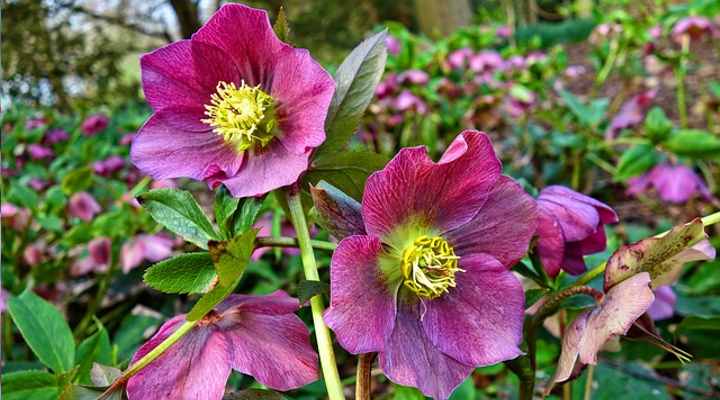
Lenten roses have vibrant flowers that brighten partially shaded areas near maple trees. The evergreen perennials feature large bowl-shaped flowers blooming in late winter to early spring. The attractive flowers bloom in a variety of colors, including white, pink, purple, white and green. They have large bluish-green leathery leaves.
Lenten roses are low-maintenance plants that are deer-resistant and drought-tolerant once established. They are perfect for adding color and texture to the shaded areas under maple trees. The self-seeding plants with their nodding flowers come back year after year to grace the floor of sheltered woodlands.
- USDA Planting Zone: 4 to 9
- Sun Exposure: Full sun to partial shade
- Blooming Season: Late winter to early spring
- Mature Size: 2 to 3 ft. (0.6 – 1 m) tall and wide
- Growth Rate: Moderate spread through self-seeding
Lily of the Valley (Convallaria majalis)
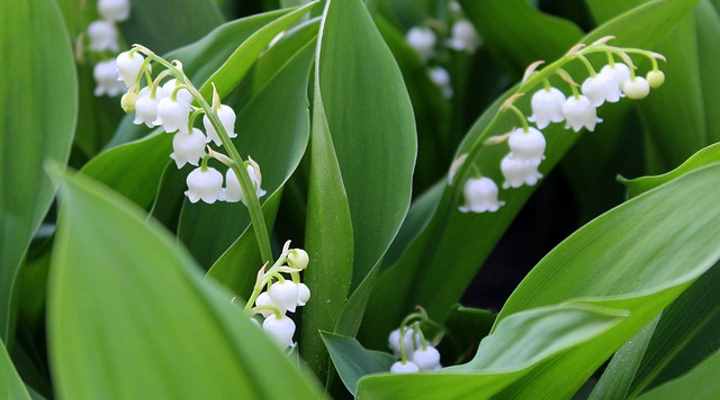
Lily of the valley has beautiful white urn-shaped flowers and lush foliage that brighten shaded maple woodlands. The white-flowering understory plant has small, fragrant white flowers dangling from arching stems. It has attractive lance-shaped green leaves that provide lush cover in shady areas, growing up to 1 ft. (0.3 m)
Lily of the valley adds a pop of bright color, powerful floral aromas, and lush foliage. The flowers complement other shade-tolerant plants like hostas and ferns in woodland gardens. It needs moist ground, so it’s best planted at the edge of a maple tree canopy. It’s good to note that the plant is highly toxic.
- USDA Planting Zone: 2 to 7
- Sun Exposure: Partial shade to full shade
- Blooming Season: Mid to late spring
- Mature Size: 6” to 12” (15 – 30 cm) tall and wide
- Growth Rate: Spreads rapidly and forms colonies over time
Canadian Wild Ginger (Asarum canadense)

Canadian wild ginger is a shade-loving perennial plant that thrives in the understory of maple trees. This low-growing plant is characterized by its unique, bell-shaped, reddish-brown flowers and heart-shaped leaves. The flowers are difficult to spot because they grow at ground level, hidden beneath the foliage.
Canadian wild ginger creates dense ground cover around maple trees. It spreads vigorously by its fleshy rootstock. Once established, it tolerates drought periods and partial to deep shade.
- USDA Planting Zone: 3 to 7
- Sun Exposure: Partial shade to full shade
- Blooming Season: Spring to mid-summer
- Mature Size: 6” to 8” (15 – 20 cm) tall and wide
- Growth Rate: Slow growth rate
Crocuses
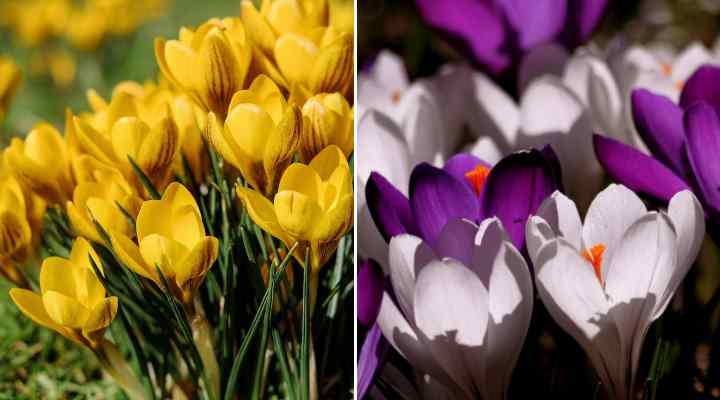
Crocuses are popular bulbous plants for growing under maple trees because they tolerate some shade and various soil types. The attractive purple, pink, white, yellow, and lilac flowers are characterized by their upward-facing cup-shaped flowers, grassy foliage, and early blooming time—sometimes while snow is still on the ground. They are one of the first nectar sources for bees.
Crocuses are easy to plant and require minimal care, making them a great choice for adding color under the canopy edge of maple trees.
Bulbs are an ideal choice for planting under maple trees because you only have to dig a small, shallow hole in the ground, which reduces the risk of disturbing the shallow maple roots.
- USDA Planting Zone: 3 to 8
- Sun Exposure: Full sun to partial shade
- Blooming Season: Late winter and early spring
- Mature Size: 4” to 6” (10 – 15 cm) tall
- Growth Rate: Slowly spreads, usually requiring thinning every three years
Creeping Phlox (Phlox stolonifera)
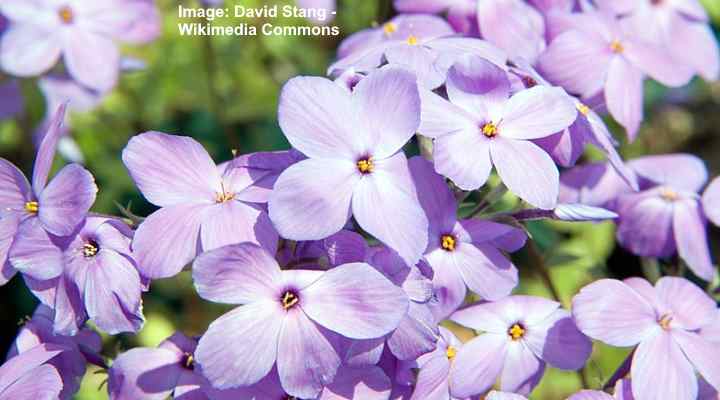
Creeping phlox is a creeping mat-forming plant ideal for landscaping under a maple tree canopy. This ground-hugging plant has outstanding five-petalled purple flowers and lush oval green leaves. The ground cover plant is ideal for partial or full shade, and it thrives in acidic soils, blooming throughout summer.
Shade-tolerant creeping phlox is easy to grow and requires little maintenance to thrive. The blanketing maple companion plant is also deer-resistant and attracts pollinators like butterflies and bees. Although not invasive, it spreads vigorously through self-seeding.
- USDA Planting Zone: 4 to 8
- Sun Exposure: Full sun, partial shade, or deep shade
- Blooming Season: Throughout summer
- Mature Size: 3” to 8” (8 – 20 cm) tall and 9” to 24” (23 – 60 cm) wide
- Growth Rate: Moderate growth rate, spreading through stolons and self-seeding
Sweet Woodruff (Galium odoratum)
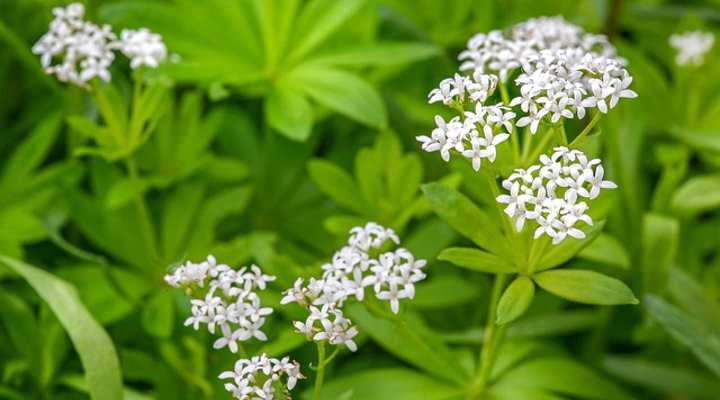
Sweet woodruff is a fragrant ground cover plant that thrives in the shade of maple trees. It has whorls of dark green leaves and small white star-shaped flowers that bloom in late spring and early summer. Sweet woodruff foliage has a sweet scent when crushed, adding to its appeal.
Sweet woodruff is a low-maintenance plant that forms a dense carpet-like cover. It is often used as a filler plant in shaded areas and is known for its ability to suppress weeds. The plant prefers well-drained soil and can tolerate dry conditions once established.
- USDA Planting Zone: 4 to 8
- Sun Exposure: Partial shade to full shade
- Blooming Season: Late spring to early summer
- Mature Size: 6 to 12 inches (15 – 30 cm) tall and wide
- Growth Rate: Slow to moderate, spreading through rhizomes
Blue Lily Turf (Liriope muscari)
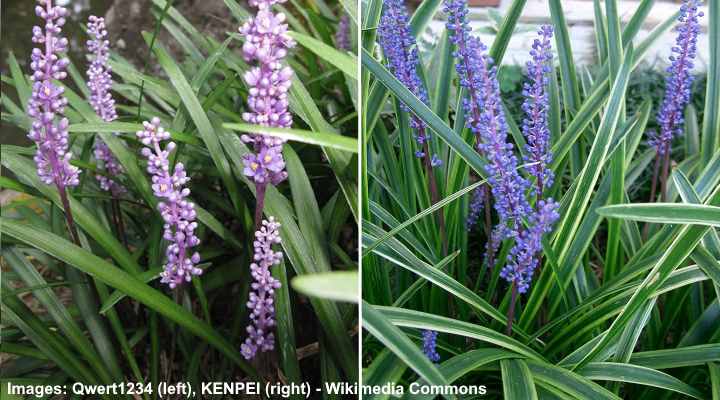
Liriope muscari grass on the left and variegated type on the right (Liriope muscari ‘Variegata’)
Blue lily turf can cover woodland floors under maple trees with soft foliage and pink or deep violet-purple flowers. The evergreen ornamental grass has tufts of slender, grass-like leaves and spikes of small, bell-shaped purple or pink flowers. Blooming from late summer through fall, blue lily turf is perfect for underplanting deciduous woodlands.
Blue lily turf thrives in acidic, well-drained soils in all shade conditions. It adds vibrant colors and lush texture to places where other flowering plants struggle. Not growing taller than two feet (60 cm), the spreading ground cover tolerates drought, humidity, heat, and deer.
- USDA Planting Zone: 5 to 10
- Sun Exposure: Full sun, partial shade, or heavy shade
- Blooming Season: Late summer through fall
- Mature Size: 1 to 2 ft. (0.3 – 0.6 m) tall and wide
- Growth Rate: Slow to moderate growth rate
Should You Plant Hostas Under Maple Trees?
Although hostas are shade tolerant perennial plants, the shallow root system of maple trees competes with hostas for nutrients and water, affecting their growth. Therefore its best to plant hostas further away from the maple tree around the canopy edge.
Hostas should not be planted in areas with excessive direct sunlight, as they prefer mostly shaded environments. They are also not suited for places where water collects, as this can lead to root rot. Poorly drained areas should be avoided, as hostas require moist but not waterlogged soil. Additionally, planting hostas in locations with heavy winds or where there is a risk of a hard freeze can stunt their growth.
How to Plant Under Maple Trees
When landscaping around maple tree roots, select small plants that can fit between the roots without suffocating them. Opt for shade-tolerant and drought-resistant plants such as sweet woodruff, and ferns. Apply a few inches of loose compost or other organic matter as mulch to retain soil moisture and improve drainage. Water the plants carefully, using a soaker hose to avoid excess watering and the growth of moss. Following these steps can help create a thriving garden around your maple trees.
Landscaping Ideas to Enhance the Beauty of Maple Trees
Maple trees add a touch of natural elegance to any landscape, and with thoughtful landscaping, you can further enhance their decorative appeal. From creating intricate tree ring designs to employing accent lighting, there are various ways to elevate the aesthetic beauty of your maple trees.
Tree Ring Design
Create a visually appealing tree ring around your maple tree by incorporating various plants and flowers that complement the tree’s aesthetics. Opt for low-maintenance ground covers, such as ferns, to add texture and greenery to the base. Consider adding contrasting colors with flowering perennials or annuals that thrive in partial shade. Use mulch to define the ring and prevent weed growth.
Mulching Techniques
Implement proper mulching techniques to protect the soil around your maple tree and promote healthy growth. Apply a layer of mulch around the base of the maple tree, ensuring it is not directly touching the trunk. Use organic mulch materials, such as wood chips or shredded bark, to retain moisture, regulate soil temperature, and inhibit weed growth. Replenish the mulch layer over the shallow maple roots annually to maintain its effectiveness.
Accent Lighting
Highlight the beauty of your maple tree during nighttime by installing accent lighting. Strategically place landscape lights around the tree to illuminate its structure and create an enchanting ambiance in your outdoor space. Use soft, warm lights to enhance the tree’s silhouette and provide a welcoming atmosphere. Experiment with different lighting angles to accentuate the tree’s unique features.
Pruning and Trimming
Regularly maintain your maple tree through pruning and trimming to ensure its health and visual appeal. Remove any dead, diseased, or overgrown branches to promote better air circulation and sunlight penetration. Maintain the tree’s natural shape while eliminating any hazards or obstructions. Conduct pruning during the tree’s dormant season to minimize stress and encourage new growth.
Installing a Bench or Seating Area
Enhance the functionality of your outdoor space by incorporating a bench or seating area near your maple tree. Choose a location that allows for an unobstructed view of the tree’s beauty while providing a comfortable and relaxing spot for you and your guests. Consider integrating natural elements, such as stone or wood, to complement the tree’s surroundings and create a tranquil environment.
Planting Plants in Pots Under Maple Trees
Planting plants in pots under maple trees can provide a practical solution to the challenges posed by the tree’s shallow root system. Select plants with shallow root systems, shade tolerance, and drought resistance, such as hellebore, vinca minor, sedum, ferns, daffodils, lily of the valley, daylilies, tulips, and crocus. Using pots allows for better control over the planting environment and enables you to place them where you want, irrespective of the aggressive maple root system.
Related articles:
